For the Covestor TenStocks portfolio, 2013 will remembered as the year of the Aveo Pharmaceuticals (AVEO) investment.
The S&P 500 Index (SPX) closed 2013 up around 32%—its best year since 1997—and the MSCI World Index finished up 24%. My portfolio, on the other hand, only managed to finish the year down 1.9% for the year. In my opinion, this awful under-performance relative to the market was almost totally due to my failed Aveo investment.
Running a concentrated portfolio means I can get a lot of price volatility. And it’s not always pleasant price volatility. On a year to year basis, the ride can get very bumpy.
That’s why I believe my work needs to be averaged over a five-year time frame. Five years helps even out the annual lumps and, in my opinion, gives a clearer and more dependable picture of how I am doing.
However, the Covestor Tenstocks portfolio does not have a five year track record yet. Since inception on May 19, 2010, its annualized return has been, well, close to zero, and it has significantly underperformed the market.
I’ve been investing successfully for over two decades, and I’ve been through bad patches before. The worst period for me was in the late nineties when I lost money for three consecutive years. It wasn’t fun, but I got through it to enjoy substantially better times.
With 2013 behind us, I now need to look forward. I need a good 2014. So, let’s look ahead.
On a macro level, I view the market as overvalued. Total market capitalization to GDP is currently around 120 percent. The average market cap-to-GDP ratio over the last 80 years is around 60. History suggests that a buyer of the market at these levels can expect forward annual returns of around 2%.
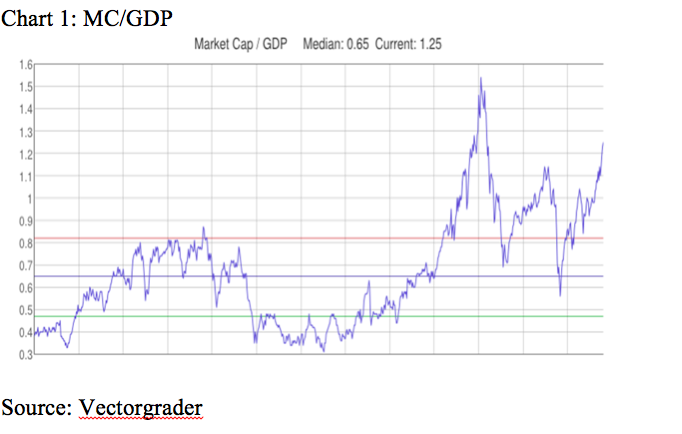
The Shiller price to earnings ratio is another indicator of relative market value. It’s based on inflation-adjusted earnings for rolling ten year periods.
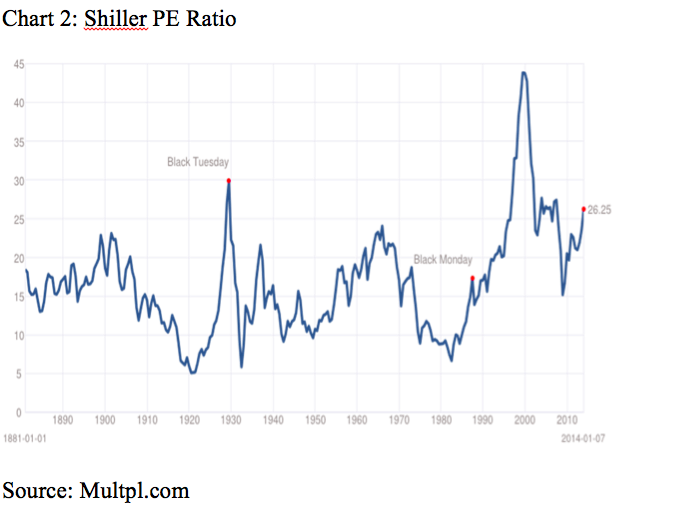 Another measure of exuberance by current market participants is outstanding margin debt. Here again, a warning sign is flashing.
Another measure of exuberance by current market participants is outstanding margin debt. Here again, a warning sign is flashing.

Another cautionary indicator of true market value is the amount of goodwill (I call it fluff) that companies are stuffing on to their balance sheets. In fact, intangible assets now account for more than 50% of the book value for S&P 500 companies.


I put together the above collection of charts not to make a case for the market’s overvaluation, but to make the case the market is not cheap. If everyone and their dog are debating whether there’s a stock bubble or not, regardless of who is right, you know it’s not a cheap market.
So, for 2014 I still think caution is warranted. I need to produce a good year, but I wouldn’t be surprised if it turns out to be a tough market in which to do it.
As anyone who follows my work knows, I try to focus my investments primarily on tangible assets and not on goodwill and other intangible fluff. I try to keep the portfolio priced at around tangible book value. In my opinion, over time this strategy has served me well. Here’s a chart that illustrates the long term success of the strategy when applied to the whole market:
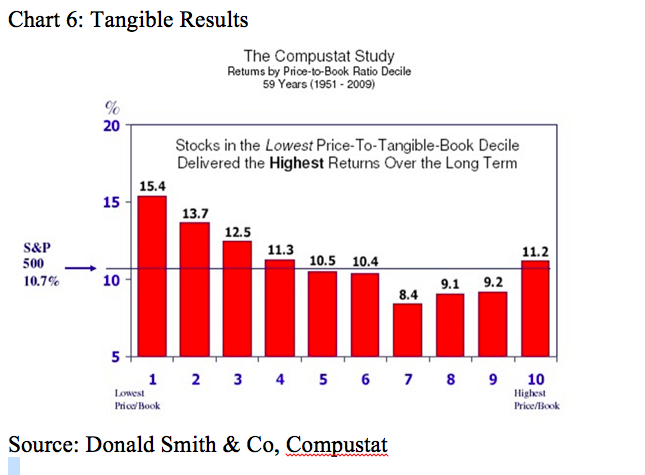
Here’s a walkthrough of the TenStocks at Covestor portfolio as we begin 2014.
Bank of America (BAC) has grown to be approximately 35% of the portfolio. I own too much of it and I do need to begin trimming it. The question is when. While I’m not very comfortable holding such a large position, I also think BAC may have another good year in 2014.
A major event for BAC in early 2014 will be the CCAR (Comprehensive Capital Analysis and Review) supervised by the Federal Reserve. They will announce the results of the review in March.
Bank of America has already submitted their capital plans for 2014 under CCAR. This includes their proposed capital allocations for stock buybacks and dividends. I have no way of knowing for sure, but I expect good news. The stock may run before official CCAR results are announced. I would not be surprised to see BAC reach our $20 price target in 2014.
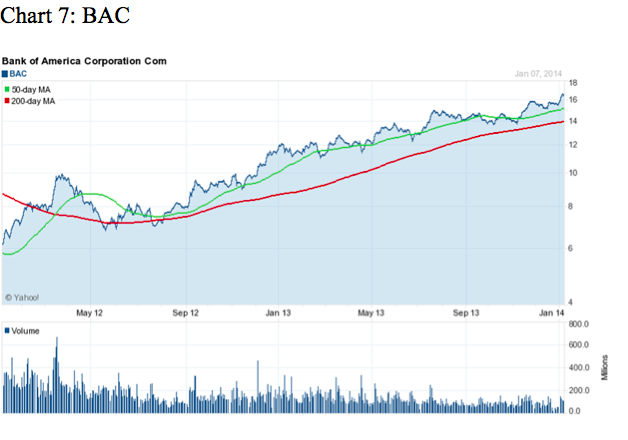
As the popularity of Argentina’s president Christina Fernandez de Kirchner falls, the market popularity of YPF rises. The underlying value of YPF’s assets was always there, but, for a time, it was overshadowed by political fear. That has changed in the last year. Barron’s recently published a bullish review of YPF. You can read it here.
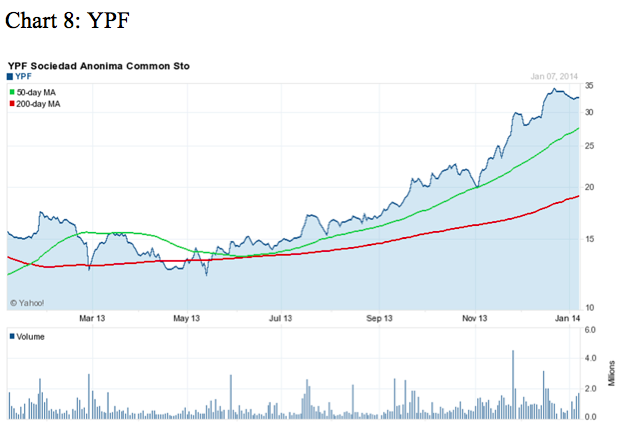
I recently added some Penn West (PWE), a Canadian oil and gas company. Penn West has new management. The company is selling off assets to improve its balance sheet, and is focusing its resources on what they consider to be their most promising prospects.
PWE pays a current dividend of around 6% and is priced at a discount to the value of its assets.
The Flaherty & Crumrine Dynamic Preferred and Income Fund (DFP) has the longest name I have ever invested in. Approximately 80% of the DFP portfolio is invested in US (70%) and British (12%) banks and insurance companies.

Although the dividends reflect past performance, at the time of this writing the fund had increased its annual dividend to 9.1%.
Exco (XCO) is a natural gas and oil company. In 2010, Douglas Miller, the ex-CEO, tried to take XCO private at $20.50 a share. He failed. Cash strapped but asset rich, XCO attracted the attention of Wilbur Ross, who started buying shares.
Mr. Ross’ average cost on his position was around $14. He has continued to buy XCO as the share price has fallen. He currently owns about 15% of the company.
In my opinion, the attraction of Exco is the value of the reserves in the ground and the current low market price of natural gas, and the spread in natgas prices between the US and the rest of the world where natgas costs much more.
In my view, Wilbur Ross, through his investment in Navigator (NVGS) plans to export US gas and take advantage of the price spread and the transportation demand it will create. But, at the moment, Exco is cash-strapped and could be forced, in the near term, to sell some of its valuable assets at a discount.
To help solve this problem, Exco announced a rights offering to raise cash. Mr. Ross and Mr. Watsa announced they would buy all the shares other Exco investors do not purchase through the rights offering. In my opinion, the timing of the rights offering—in a tight window that included Christmas and New Year—strongly suggest Mr. Ross and Mr. Watsa want to buy up as many shares as they can at the offering price of $5 a share.
Once the rights offering is closed, and XCO’s cash position is improved, along with some press about Wilbur and Prem’s increased ownership percentage, I expect to see some steady improvement in XCO’s share price.
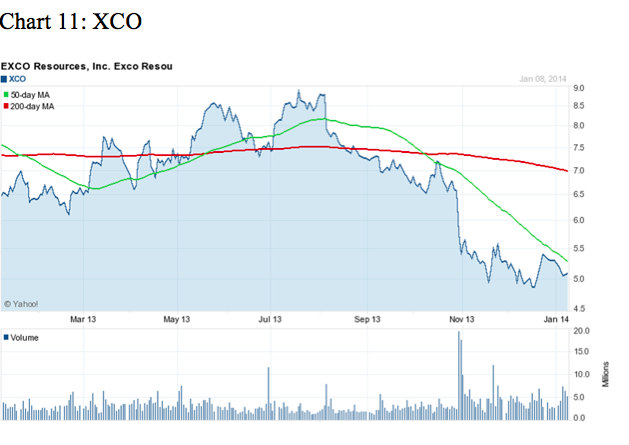
I was planning to sell Aveo in December 2013 to book a tax loss. In the end, I changed my mind. I was hoping for some kind of deal news on Aveo in 2013. It never came. The share price has eroded due to continued cash burn and year-end tax loss selling.
So I held on. On December 18, Great Point Partners, a private equity firm who specialize in healthcare investments, announced a 5.65% ownership position in Aveo.
This intrigued me because on December 19, only one day later, Great Point announced the closing of a new $215 million health care buyout fund. Aveo’s current market cap is around $90 million (with approximately $110 million in cash and marketable securities on the balance sheet).
I have no way of knowing this for sure, but I believe there’s about $5 a share in total value in Aveo despite having a good kidney cancer drug they can’t sell. To be clear, I need a minor miracle to even get anywhere near half our money back on Aveo. But, in the end, I decided to hold my shares into 2014.
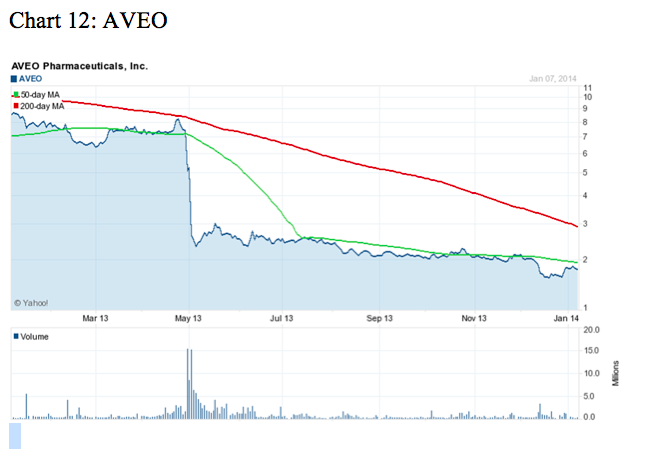
I still hold the Proshares Ultrashort Russell 2000 (TWM) position in the Tenstocks portfolio. It’s been very expensive to keep through a raging bull market as you can see in the chart below.

I started 2014 with roughly 35% of the portfolio in cash. If the market takes a hit for whatever reason, I will have plenty of buying power. With that, I will get back to work and try to produce a better 2014.
DISCLAIMER: The investments discussed are held in client accounts as of December 31, 2013. These investments may or may not be currently held in client accounts. The reader should not assume that any investments identified were or will be profitable or that any investment recommendations or investment decisions we make in the future will be profitable. Past performance is no guarantee of future results.


